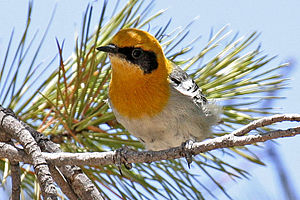Deceptive Warbler
| Deceptive Warbler | ||||||||||||
|---|---|---|---|---|---|---|---|---|---|---|---|---|

Warbler ( Peucedramus taeniatus ) |
||||||||||||
| Systematics | ||||||||||||
|
||||||||||||
| Scientific name of the family | ||||||||||||
| Peucedramidae | ||||||||||||
| Wolters , 1980 | ||||||||||||
| Scientific name of the genus | ||||||||||||
| Peucedramus | ||||||||||||
| Henshaw , 1875 | ||||||||||||
| Scientific name of the species | ||||||||||||
| Peucedramus taeniatus | ||||||||||||
| ( Du Bus de Gisignies , 1847) |
The wood warbler ( Peucedramus taeniatus ) is a small songbird that was first assigned to the wood warbler family (Parulidae), but according to DNA studies it was the only representative in its own family wood warbler (Peucedramidae). The distribution area extends from southwestern North America through Mexico , Guatemala , El Salvador and Honduras to Nicaragua . The IUCN lists the species as "not endangered" (least concern).
features
Trugwaldsänger reach a body length of 13 centimeters. The wing length is 6.8 to 8.1 centimeters in the male, 6.7 to 7.5 centimeters in the female. Adult male Trugwaldsänger of the nominate form have an orange upper head, neck and neck plumage as well as an orange throat and upper breast plumage. The reins , the eye area and the ear covers are black. The wings are blackish with olive feather edges and two broad white wing bands. The upper side plumage is gray; the underside plumage is dirty white with gray washed-out breasts and flanks. In the females of the nominate form, the reins and ear-covers are grayish-black and the plumage of the head and neck and the upper coat are yellowish olive-green. The rest of the head plumage, the sides of the neck and the chest are yellow; the throat feathers a little pale yellow.
Male juveniles of the nominate form have duller plumage in the first year of life than the adult males. The reins and ear-covers are dull blackish. The crown and neck plumage and the upper mantle are yellow-olive and the sides of the neck and chest are orange-yellow; a little lighter at the throat. The female fledglings in the first year have greyish reins and ear covers. The crown and neck plumage is grayish, washed-out yellow-olive. The upper side plumage is olive gray.
Occurrence, nutrition and reproduction
Trugwaldsänger inhabit pine-oak forests and fir forests mostly at altitudes of 2500 to 4000 meters. They are predominantly resident birds , with the exception of the subspecies Peucedramus t. arizonae : Some individuals of this subspecies migrate from Arizona and New Mexico to the range in northwestern Mexico over the winter and return in early April. The birds in the area of the outermost border of Arizona to Mexico mainly stay in their areas, rarely they migrate to Texas.
In winter, individual animals or small groups often join forces with warbler species to form small swarms. They feed mainly on insects that they look for in the middle and higher vegetation. They use a behavior similar to that of the pine wood warbler ( Dendroica pinus ) and the golden-throated wood warbler ( Dendroica dominica ). Often they can be spotted like this creeping along pine branches or, due to the similar structure of the beak, examine cracks and crevices in the tree bark.
The breeding season is from May to July. The compact, bowl-shaped nest made of moss, lichen and plant roots place the warbler on the outer ends of conifer branches at heights of 10 to 23 meters. The nest is lined with fine plant and root fibers. A clutch consists of three to four eggs. Information on the incubation and nestling time is not available.
Subspecies and distribution
There are six recognized subspecies:
- Peucedramus t. taeniatus ( Du Bus de Gisignies , 1847) - Occurs from Guerrero in Mexico via south-central Mexico to Guatemala.
- Peucedramus t. aurantiacus Ridgway , 1896
- Peucedramus t. arizonae Miller & Griscom , 1925 - Widespread in southeastern Arizona and southwestern New Mexico to northwestern Mexico ( Chihuahua , Sinaloa, and Durango )
- Peucedramus t. jaliscensis Miller & Griscom, 1925 - Mexico (From Jalisco east to Nuevo León and Tamaulipas )
- Peucedramus t. micrus Miller & Griscom, 1925 - Distributed from El Salvador and Honduras to Nicaragua.
- Peucedramus t. giraudi J. T. Zimmer , 1948 - Mexico (From Jalisco and Michoacán east to the central west of Veracruz )
swell
literature
- Jon Curson, David Quinn, David Beadle: New World Warblers. Helm, London 1994, ISBN 0-7136-3932-6 .
Web links
- Peucedramus taeniatus inthe IUCN 2012 Red List of Threatened Species . Listed by: BirdLife International, 2012. Retrieved September 11, 2012.
- BirdLife International: Species Factsheet - Olive Warbler ( Peucedramus taeniatus ) . Retrieved September 11, 2012.
- Videos, photos and sound recordings for Olive Warbler (Peucedramus taeniatus) in the Internet Bird Collection
- Warbler ( Peucedramus taeniatus ) at Avibase; Retrieved September 11, 2012.
- Peucedramus taeniatus in the Integrated Taxonomic Information System (ITIS). Retrieved September 11, 2012.
- xeno-canto: Sound recordings - Olive Warbler ( Peucedramus taeniatus )
